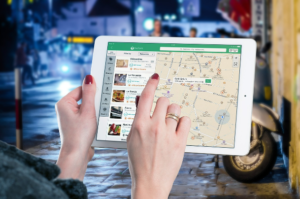Transportation is a massive industry that affects everyone, whether you’re using a rideshare app, a public transportation service, a private limousine or your own private vehicle. We rely on transportation not only for ourselves but also to get our children to and from school and activities, to bring products to our doorsteps and to the stores we love to shop at and much more.
Technology and transportation go hand-in-hand. At the root of all technological advancements is one common goal: to make life easier. In terms of transportation, this means making it faster, more convenient, safer, and even more affordable.
These are five ways that technology has evolved(and will continue to evolve) the transportation game for everyone.
Table of Contents
Traffic Data Has Helped Plan Better Routes
GPS technology is now practically a second thought. It’s built into almost any new car you purchase, is standard on any mobile device and has made the classic road atlas obsolete. GPS apps and systems are getting more sophisticated thanks to the massive amounts of traffic data available. This allows a GPS system not just to show the fastest route but the most logical one based on the current traffic information, weather and other factors. This helps drivers avoid heavy congestion and keeps cars on the roads moving quicker.
Live traffic data is an essential part of the transportation game now, and its effect is felt in all aspects of the industry. Even the other tech-influenced trends in this discussion are, to some degree, helped by the ability to accurately detect and plan around heavy traffic and devise better routes.
Public Transportation Is More Convenient and Accurate
If you’ve ever had to rely on public transportation for your daily commute, then you know the pain of how inaccurate and troublesome any transit system can be. Technology has made the public transportation game a lot more reliable and convenient. Most major public transportation hubs feature an app that riders can download to see a map showing where their bus is and up-to-the-minute information on when exactly the bus is expected to arrive. This makes planning your commute much more relaxed, so you’re never stranded at a bus stop wondering why it is taking so long.
Some transit organizations are allowing riders to pay via their smartphone, which streamlines the process of people getting on and off the bus. While this may only save a few seconds on your trip, when you consider that 35 million people board public transportation every day, those seconds add up to a faster overall commute.

Ridesharing Apps Provide On-Demand Rides
Millennials coming of age now will sparsely know the feeling of being stranded on a rainy street without a taxi in sight because so many of these individuals are equipped with a mobile smartphone and a ridesharing app. Ridesharing is comparable to calling a cab, but at the same time different.
One significant difference is rideshare drivers, whether they are operating for Uber, Lyft or another service, are everywhere and take only a few minutes to arrive (in most cases). Taxis, on the other hand, only typically operate out of large cities, where there’s ample business. If you don’t live in or near a city with a large taxicab hub, you could be waiting a long time and pay a lot to call a cab to your area.
You can spend hours looking at the price difference between rideshare and taxi services, but the real competitive differentiator is convenience and how easy it is to lock down a ride. Uber and the other major rideshare players have a clear advantage here.
Ridesharing Apps Have Created an Alternate Income For Millions
Rideshare companies have exploded in just a few short years. Their lightspeed rise to the top has been a hard blow for long-established taxi companies. Not only are these ridesharing companies a convenient, on-demand car service for millions of individuals that use these apps, but they are also a new secondary (sometimes primary) source of income for many of the drivers behind these apps.
According to US Bureau of Labor Statistics, rideshare drivers cite three critical reasons for driving with Uber or another similar service:
- Earn more income to support a family (number one reason people drive for a rideshare company)
- Be their own boss
- Create a more flexible schedule to manage work and family
With how popular ridesharing has become, there’s a lot of tips and advice online from other drivers that can help you learn how to make $1,000 or more a month by using Uber, Lyft, or another service as a source of income.
Safety Continues To Reign Supreme
No matter if you’re driving or being driven, there is one trend that affects all riders on the road: technology is making roads safer. Rideshare services cut down drunk driving accidents each month. Cars equipped with accident detection software that can engage brakes and even the car’s steering impede collisions. And, driver safety monitoring meters can tell when a commercial driver is driving too fast or erratically and report the behavior. The bottom line is the roads today are safer thanks to technology.
Conclusions
While we may be years away from widespread use of driverless cars or Jetsons-style flying cars, technology is doing its duty by nudging the transportation industry towards a safer, more convenient and all-around better future.


